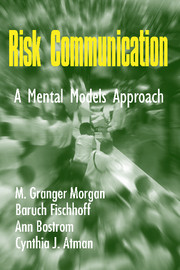Book contents
- Frontmatter
- Contents
- Preface
- Risk Communication
- 1 INTRODUCTION
- 2 OUR MENTAL MODELS APPROACH
- 3 CREATING AN EXPERT MODEL OF THE RISK
- 4 MENTAL MODELS INTERVIEWS
- 5 CONFIRMATORY QUESTIONNAIRES
- 6 DEVELOPMENT AND EVALUATION OF COMMUNICATIONS
- 7 CASE STUDIES: APPLICATIONS TO ENVIRONMENTAL RISKS
- 8 A MENTAL MODELS APPROACH TO HIV/AIDS
- 9 SOME CONCLUDING THOUGHTS
- Appendix A Brochure on global warming and climate change
- Appendix B Brochure on fields from electric power
- Appendix C Risk communication materials on HIV/AIDS
- Appendix D Sample transcripts of mental model interviews
- Index
3 - CREATING AN EXPERT MODEL OF THE RISK
Published online by Cambridge University Press: 05 June 2012
- Frontmatter
- Contents
- Preface
- Risk Communication
- 1 INTRODUCTION
- 2 OUR MENTAL MODELS APPROACH
- 3 CREATING AN EXPERT MODEL OF THE RISK
- 4 MENTAL MODELS INTERVIEWS
- 5 CONFIRMATORY QUESTIONNAIRES
- 6 DEVELOPMENT AND EVALUATION OF COMMUNICATIONS
- 7 CASE STUDIES: APPLICATIONS TO ENVIRONMENTAL RISKS
- 8 A MENTAL MODELS APPROACH TO HIV/AIDS
- 9 SOME CONCLUDING THOUGHTS
- Appendix A Brochure on global warming and climate change
- Appendix B Brochure on fields from electric power
- Appendix C Risk communication materials on HIV/AIDS
- Appendix D Sample transcripts of mental model interviews
- Index
Summary
If communications are to be authoritative, they must reflect expert understanding. To that end, the first step in developing risk communications is creating influence diagrams that summarize the relevant expert knowledge. As mentioned, although it is called an “expert model,” the information that it contains need not reside in the mind of any one expert, especially not in such explicit form. Indeed, the creation of an expert model can be a complex, creative act, forcing participating experts to reflect systematically on the structure of their domain.
Even when chosen for expertise about a specific risk, such as indoor radon, an expert is likely to know a lot more than most of us need to know about that risk. Some expert knowledge is likely to be arcane or simply irrelevant to the decisions that risk communication recipients face. Much expert knowledge is too detailed or peripheral to guide risk communication development. The decision or set of decisions that your communication will inform may be defined in part by the experts you consult, who have specialized knowledge about risk mitigation. But once that decision set is defined, it should guide your expert model development as well. In Section 3.2, we discuss converting scientific information about risk into a decision model, such as an influence diagram.
Influence Diagrams
Influence diagrams were developed by decision analysts as a convenient way to summarize information about uncertain decision situations, allowing effective communication between experts and decision makers and the conduct of information-related analyses (Howard and Matheson, 1981; Shachter, 1988).
Information
- Type
- Chapter
- Information
- Risk CommunicationA Mental Models Approach, pp. 34 - 62Publisher: Cambridge University PressPrint publication year: 2001
